Vintage Watson Bactil Technical Binocular Microscope, Broad-Arrow Marks c1964
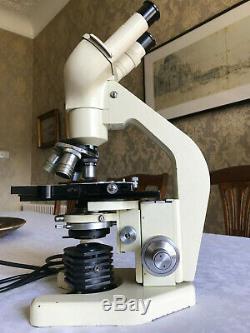
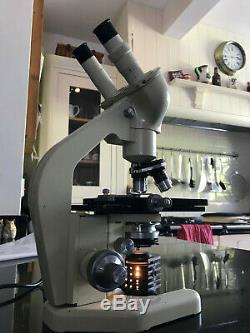
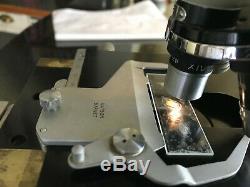
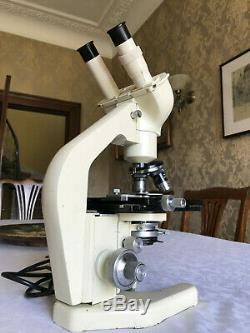
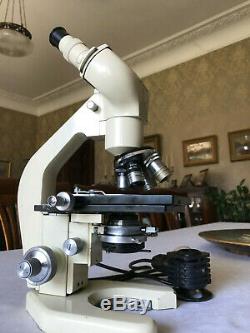

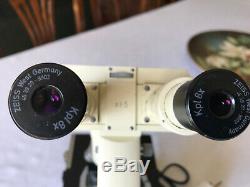

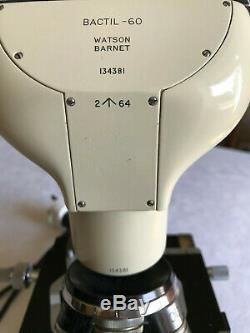
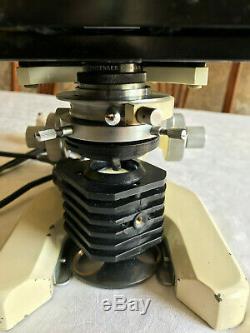
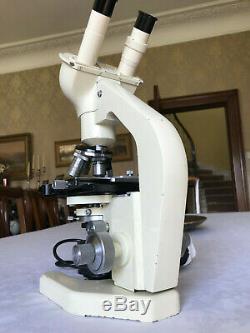


Foreword about the Watson Bactil. Throughout the 1960s and 1970s pathology labs were completely dependent on the Watson Bactil model of microscope - it was the backbone technical microscope of that era and to describe the Bactil as the workhorse of medical diagnosis would also be pretty accurate. Therefore, generations of medical technicians and pathologists alike have used these amazing pieces of British microscopical engineering, hence most examples on the market today show evidence of being well used. But, these quality microscopes can take it because they emanate from a time when quality mattered, a time when quality materials, were allied with great design features and it was all put together by conscientious assembly workers at the Watson manufacturing facility.
Therefore the Bactil model makes a great collector's piece and it's also more than capable of still being used as a versatile technical microscope. This example is serial number 134381 and we can date it's manufacture to around 1961-2; it's from the period when the original optical manufacturing company of Watson & Sons had changed their trading name to Watson Barnet.
It's also got broad-arrow markings for February 1964 on both the frame and condenser, therefore indicating acquisition via a military procurement contract at that time, probably acquired from existing Watson inventory. This instrument has a comprehensive technical configuration with a set of lenses that mirrors what this example would have been fitted with originally. The overall construction is very solid with much use of metals such as iron and brass with base, stage and upper all of really heavy construction. This model is painted in off-white and Watson used black paint for their classic Bactil models until about 1960 when they launched this model in parallel, switched to an off-white painted finish and christened the model the "Bactil -60", probably referencing the new decade of the 1960s. This colour change may have also had something to do with NHS and military procurement contracts and the requirements thereof relating to equipment that was going to be used in a clinical/laboratory setting.The off-white paint finish is in good shape with some minor signs of wear on the frame where one would expect. The bright-work components are all nickel-plated and have polished up quite well. This Watson Bactil has rack and pinion main and fine focusing via concentric thumb-wheels at the base of the frame, both of which move reasonably smoothly with some signs of wear but still functional. It's interesting to note that coarse focus moves the main frame (limb) whereas fine focus moves the stage.
This example comes fitted with a quality set of two Zeiss 8x magnification matched eyepieces for the binocular head. The binocular unit is +1.5x times magnification therefore giving 12x magnification at the eyepieces. The microscope is fitted with a quadruple nose-piece and comes supplied with four objective lenses with progressive magnification, as follows. 50x Watson 3.6mm fluorite - oil immersion (not tested). 100x Watson 2mm fluorite - oil immersion (not tested).
The effective magnification range available from a combination of all supplied lenses is therefore around 120x to 1,200x with oil immersion techniques. The fully mechanical stage set-up has x-axis and y-axis controls offering good control during specimen viewing. The original Watson stage-clip system for holding slides in place on the stage for viewing purposes is also present. There is some very minor evidence of wear to the painted finish on the stage surface and also a little drag in the y axis movement - the stage mechanisms have already been dismantled and lubricated and this process just needs to be repeated. There was also a tiny amount of wobble to the stage, probably owing to wear in the rack and pinion systems, but this doesn't cause any issues. Below stage there is a Watson Universal No. 1 Abbe condenser with fully working iris on a rack and pinion mount, the condenser being adjustable for side-to-side position as well as height; the condenser is also fitted with a filter holder for coloured or dark-field filters. There is an aftermarket electric sub-stage illuminator for lighting, which is in good condition and which slots into a u-shaped mounting socket in the frame and just plugs into a standard 240V wall socket.The illuminator worked fine in testing producing adequate lighting for viewing purposes. And last but not least of course, the Bactil's. This is the correct binocular head for this example, as the numbers are fully matching, confirming this example's provenance together with broad-arrow markings. The binocular head is adjustable for both focus and eyepiece separation via a central thumb-wheel.
Binocular heads can take some getting used to visually and are generally preferred for more detailed and also lengthy microscopical work. All-in-all an interesting example of a retro Watson Barnet Bactil 60 model just oozing both solidity and quality with its comprehensive technical set-up, period look and good cosmetic condition - probably an example suitable for an enthusiast or collector of quality vintage microscopes, or those interested in items with military connections. This example will make a wise addition to any collection - it really is a microscope from a bygone era when quality was paramount. With all that metal it's a really heavyweight piece and will be around 12kg packed weight, so will be sent by insured courier upon receipt of cleared funds.
Thanks for looking - please check out my other listings - mainly eclectic artworks and vintage optics, plus some other cool stuff. The item "Vintage Watson Bactil Technical Binocular Microscope, Broad-Arrow Marks c1964" is in sale since Saturday, April 25, 2020. This item is in the category "Antiques\Science/Medicine\Scientific Instruments". The seller is "arcboutant" and is located in Glasgow.
This item can be shipped to United Kingdom, Austria, Belgium, Bulgaria, Croatia, Cyprus, Czech republic, Denmark, Estonia, Finland, Germany, Greece, Hungary, Ireland, Italy, Latvia, Lithuania, Luxembourg, Malta, Netherlands, Poland, Portugal, Romania, Slovakia, Slovenia, Spain, Sweden, Australia, United States, Bahrain, Canada, Brazil, Japan, New Zealand, China, Israel, Hong Kong, Norway, Indonesia, Malaysia, Mexico, Singapore, South Korea, Switzerland, Taiwan, Thailand, Bangladesh, Belize, Bolivia, Brunei darussalam, Dominica, Ecuador, Egypt, Guernsey, Gibraltar, Guadeloupe, Grenada, French guiana, Iceland, Jersey, Cambodia, Saint kitts and nevis, Liechtenstein, Macao, Monaco, Martinique, Nicaragua, Pakistan, Peru, Paraguay, Turks and caicos islands, Aruba, Saudi arabia, United arab emirates, Chile, Bahamas, Costa rica, Guatemala, Honduras, Jamaica, Kuwait, Panama, Philippines, Qatar, Trinidad and tobago, Uruguay, Viet nam, France.
- Period: 1951 to Present
- Material: Steel
- Type: Microscope

